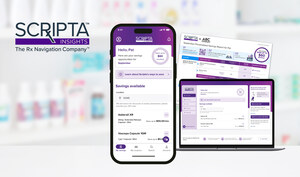Consumers In Pain Over High Prescription Prices, Ready To Take Action And In Need Of Better Tools, According To Survey By Scripta Insights
96% of Consumers Are Willing to Make a Prescription Change--Switch Meds, Forms, or Where They Fill--to Save Money
Despite Fanfare Around GoodRx and Amazon Pharmacy, Only 16% Look for a Coupon When They Can't Afford Their Meds
WELLESLEY, Mass., April 14, 2021 /PRNewswire/ -- It's no secret prescription drugs are pricey. So, it's not surprising that "Expensive, Necessary and Cost(ly)" are the first three words that come to mind when people think about prescription drugs. That's according to the results of an online survey released today by Scripta Insights, a cloud-based healthcare IT solution that helps self-insured employers contain their pharmacy benefit spend, while helping members get The Right Meds at the Best Price™.
Scripta surveyed 372 respondents, ages 18-60+, in Q1 2021 to delve deeper into American attitudes and behaviors around prescription drug pricing. All respondents have health insurance through their employer and take one or more prescription drugs on a regular monthly basis.
Interestingly, three key themes emerged: there's a hidden culprit for high prescription drug prices, the PBM; the doctor is trusted and a key stakeholder in consumer-directed healthcare; and patients are eager, regardless of household income, to make a prescription change to save as little as $15 monthly.
People are in Pain at the Pharmacy Counter, the PBM Remains the Hidden Culprit
Despite having health insurance, on average, two-thirds of survey respondents (66%) think they pay too much for prescription drugs. Upon further review, that sentiment grows and directly correlates to how much they spend out of pocket monthly: ranging from 45% for those spending under $15, to an alarming 86% for those who spend $50.01 or more.
Who's to blame? People believe pharma companies are the number one offender (52%) most to blame for high prescription drug prices, followed by insurance companies (17%) and the government (15%). Only 5% blame PBMs.
What's driving prescription drug pricing? Respondents think it's three main factors equally responsible (approx. 30% each): marketing/advertising, drug ingredients/manufacturing, and research & development. Only 10% think it's due to PBM fees & rebates.
In reality, industry data shows that PBM fees & rebates actually drive many of patients' problems and misunderstandings of U.S. drug prices. Drug Channels Institute estimates that the gross-to-net bubble—the dollar gap between sales at brand-name drugs' list prices and their sales at net prices after rebates and other reductions—reached $175 billion in 2019.
Scripta's survey also reveals most people (71%) believe that coupon and discount services like GoodRx, Blink Health and Amazon Pharmacy are helping to solve the high cost of prescription drugs. Yet, despite the fanfare, only 16% of people report looking for a coupon when they can't afford their meds.
"Pharmacy coupon and discount services aren't treating the condition of high prescription drug prices, they're merely treating its symptoms; they're not getting rid of your brain tumor, they're just making your headache feel better today," said Eric Levin, CEO, Scripta Insights. "Coupon services are all promoting the same PBM-based system that is the hidden culprit behind the high costs on the majority of drugs in the U.S."
Patients Becoming Better Prescription Shoppers, Want Price Transparency
People are carefully monitoring their prescription spend and aren't afraid to ask for pricing information:
- The majority (73%) of people who are on a deductible plan know where they are with their deductible and the impact it will have on their prescription costs before they go to the pharmacy
- At the pharmacy counter, more than half of people (57%) have asked if the cash price of a drug is cheaper than the price through their insurance
- 60% of patients have asked their doctor the cost of a drug when getting a new script
The doctor remains the go-to source for patients seeking more affordable drug options, but patients feel doctors are lacking critical pricing information and need better tools:
- When faced with pharmacy counter sticker shock, the most popular action people take is to ask their doctor for a cheaper option. Next, they ask their pharmacist.
- However, half of patients (51%) don't believe their doctor knows the price they will pay for the drug they're prescribing
"People trust their doctors and want to take the medicine their doctor prescribes, but affordability has a major impact on adherence—I've seen it with my own patients," said Paul Bradley, M.D., Chief Medical Officer and head of the P&T Committee at Scripta Insights. "Believe it or not, most doctors don't know the cost of a drug or what the member copay is on your insurance plan when they write your prescription. At Scripta, we provide our members with the information they need to be better prescription shoppers and have more informed conversations with their doctor."
Patients are Very Willing to Change Medications to Save on Rx
More than half of people (58%) have received a recommendation to take a different less expensive drug for their medical condition, with advice coming from trusted sources, including experts like their doctor or pharmacist (54%) or non-experts like a family member or friend (32%).
The top three reactions to this news? Overwhelmingly, people are "interested" (58%), followed by "excited" (36%) and "surprised" (35%) to learn there could be a cheaper option out there.
If their doctor said it was ok, 96% of respondents are willing to make a prescription change (i.e. switch their script, change forms or where they fill their medication) to pay less for their meds. Nearly half of those surveyed (46%) are willing to switch to a new medication to save as little as $15 per month.
The most popular prescription switches people are willing to make include switching from a brand name to a generic drug (70%) and switching to a different brand name drug (52%). Roughly 25% of patients are also willing to take the following actions to save on Rx:
- Get a new prescription for a higher dosage pill and split it in half with a pill splitter
- Switch to a different pharmacy
- Take two prescription drugs instead of one
- Take a different form of drug (i.e. a gel instead of a cream)
- Take the drug more frequently (i.e. 2x daily instead of 1x daily)
Scripta offers a prescription savings benefit to members through self-insured employers. Scripta reviews each member's recent prescriptions, analyzes them using their exclusive savings database, and finds savings opportunities. Members receive Personalized Savings Reports with lower-priced options, that are the same or equivalent to their meds, to discuss with their doctor.
About Scripta Insights
Scripta Insights, a company founded by doctors, is using technology to create transparency, disrupt and improve the $300B self-funded pharmacy benefits marketplace.
Scripta is a healthcare IT solution that delivers immediate, real savings on pharmacy benefit costs for self-insured employers, payers and their members. It empowers companies to take control of their pharmacy spend, while helping members get the medicine they need at the best possible price.
Scripta's proprietary software, Script.AI, was developed over a decade and is designed to analyze millions of pharmacy transactions in mere seconds to yield actionable insights. It uses data analytics, AI and expert insights from its P&T Committee to recognize savings opportunities that, until now, have been impossible to identify.
Scripta has saved employers and members millions of dollars on prescriptions.
For more information about Scripta, visit www.scriptainsights.com.
CONTACT:
Stephanie Ciosek,
[email protected],
914-806-5767
SOURCE Scripta Insights

Related Links
WANT YOUR COMPANY'S NEWS FEATURED ON PRNEWSWIRE.COM?
Newsrooms &
Influencers
Digital Media
Outlets
Journalists
Opted In






Share this article